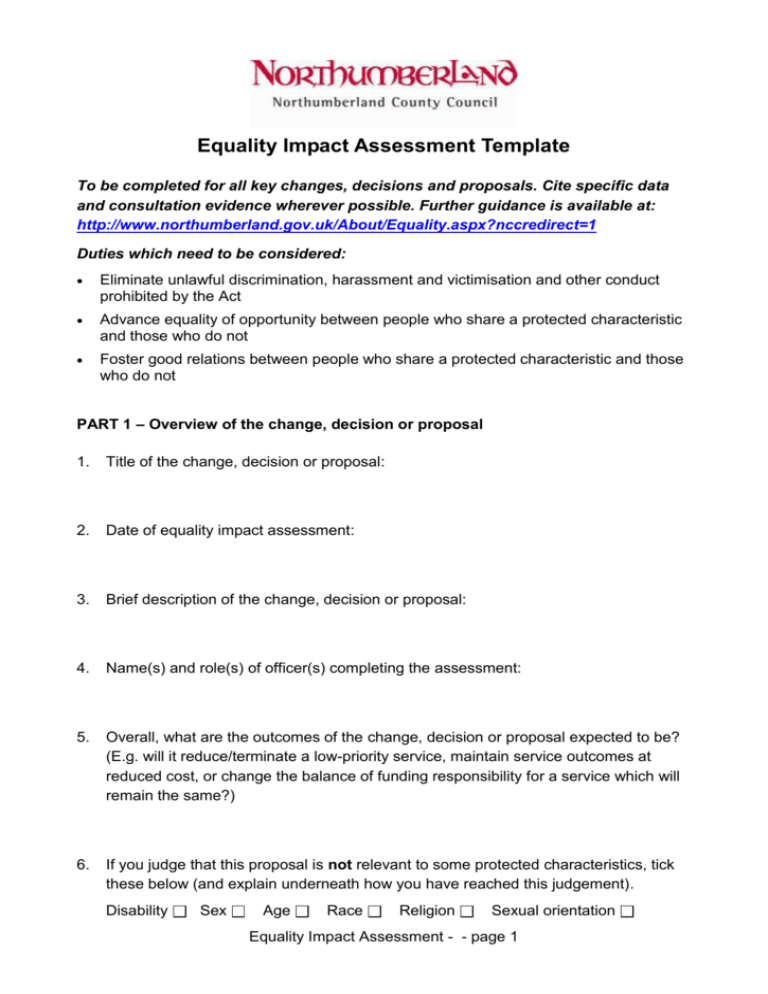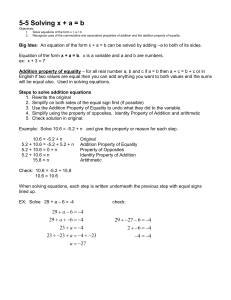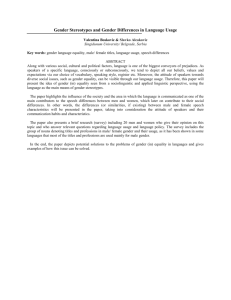
Equality Impact Assessment Template
To be completed for all key changes, decisions and proposals. Cite specific data
and consultation evidence wherever possible. Further guidance is available at:
http://www.northumberland.gov.uk/About/Equality.aspx?nccredirect=1
Duties which need to be considered:
Eliminate unlawful discrimination, harassment and victimisation and other conduct
prohibited by the Act
Advance equality of opportunity between people who share a protected characteristic
and those who do not
Foster good relations between people who share a protected characteristic and those
who do not
PART 1 – Overview of the change, decision or proposal
1.
Title of the change, decision or proposal:
2.
Date of equality impact assessment:
3.
Brief description of the change, decision or proposal:
4.
Name(s) and role(s) of officer(s) completing the assessment:
5.
Overall, what are the outcomes of the change, decision or proposal expected to be?
(E.g. will it reduce/terminate a low-priority service, maintain service outcomes at
reduced cost, or change the balance of funding responsibility for a service which will
remain the same?)
6.
If you judge that this proposal is not relevant to some protected characteristics, tick
these below (and explain underneath how you have reached this judgement).
Disability
Sex
Age
Race
Religion
Sexual orientation
Equality Impact Assessment - - page 1
People who have changed gender
Women who are pregnant or have babies
Employees who are married/in civil partnerships
Double-click this link to modify the form to match this list
After considering employees and service users, the characteristics checked
above are not relevant because:
PART 2 – Relevance to different Protected Characteristics
Answer these questions both in relation to people who use services and employees
Disability
Note: “disabled people” includes people with physical, learning and sensory disabilities,
people with a long-term illness, and people with mental health problems. You should
consider potential impacts on all of these groups.
Please answer these questions with reference to our employees and people who
use our services
7.
What do you know about usage of the services affected by this change, decision or
proposal by disabled people, about disabled people’s experiences of it, and about
any current barriers to access?
8.
Could disabled people be disproportionately advantaged or disadvantaged by the
change, decision or proposal?
9.
Could the change, decision or proposal affect the ability of disabled people to
participate in public life? (e.g. by affecting their ability to go to meetings, take up
public appointments etc.)
10. Could the change, decision or proposal affect public attitudes towards disabled
people? (e.g. by increasing or reducing their presence in the community)
Equality Impact Assessment - - page 2
11. Could the change, decision or proposal make it more or less likely that disabled
people will be at risk of harassment or victimisation?
12. If there are risks that disabled people could be disproportionately disadvantaged by
the change, decision or proposal, are there reasonable steps or adjustments that
could be taken to reduce these risks?
13. Are there opportunities to create positive impacts for disabled people linked to this
change, decision or proposal?
Sex
Please answer these questions with reference to our employees and people who
use our services
14. What do you know about usage of the services affected by this change, decision or
proposal by males and females, about their experiences of it, and about any current
barriers to access?
15. Could males or females be disproportionately advantaged or disadvantaged by the
change, decision or proposal?
16. Could the change, decision or proposal affect the ability of males or females to
participate in public life? (e.g. by affecting their ability to go to meetings, take up
public appointments etc.)
17. Could the change, decision or proposal affect public attitudes towards males or
females? (e.g. by increasing or reducing their presence in the community)
18. Could the change, decision or proposal make it more or less likely that males or
females will be at risk of harassment or victimisation?
Equality Impact Assessment - - page 3
19. If there are risks that males or females could be disproportionately disadvantaged by
the change, decision or proposal, are there reasonable steps or adjustments that
could be taken to reduce these risks?
20. Are there opportunities to create positive impacts for males or females linked to this
change, decision or proposal?
Age
Please answer these questions with reference to our employees and people who
use our services
21. What do you know about usage of the services affected by this change, decision or
proposal by people of different age groups, about their experiences of it, and about
any current barriers to access?
22. Could people of different age groups be disproportionately advantaged or
disadvantaged by the change, decision or proposal?
23. Could the change, decision or proposal affect the ability of people of different age
groups to participate in public life? (e.g. by affecting their ability to go to meetings,
take up public appointments etc.)
24. Could the change, decision or proposal affect public attitudes towards people of
different age groups? (e.g. by increasing or reducing their presence in the
community)
25. Could the change, decision or proposal make it more or less likely that people of
different age groups will be at risk of harassment or victimisation?
Equality Impact Assessment - - page 4
26. If there are risks that people of different age groups could be disproportionately
disadvantaged by the change, decision or proposal, are there reasonable steps or
adjustments that could be taken to reduce these risks?
27. Are there opportunities to create positive impacts for people of different age groups
linked to this change, decision or proposal?
Race
Note: For the purposes of the Act ‘race’ includes colour, nationality and ethnic or national
origins.
Please answer these questions with reference to our employees and people who
use our services
28. What do you know about usage of the services affected by this change, decision or
proposal by people of different racial groups, about their experiences of it, and about
any current barriers to access?
29. Could people of different racial groups be disproportionately advantaged or
disadvantaged by the change, decision or proposal?
30. Could the change, decision or proposal affect the ability of people of different racial
groups to participate in public life? (e.g. by affecting their ability to go to meetings,
take up public appointments etc.)
31. Could the change, decision or proposal affect public attitudes towards people of
different racial groups? (e.g. by increasing or reducing their presence in the
community)
32. Could the change, decision or proposal make it more or less likely that people of
different racial groups will be at risk of harassment or victimisation?
Equality Impact Assessment - - page 5
33. If there are risks that people of different racial groups could be disproportionately
disadvantaged by the change, decision or proposal, are there reasonable steps or
adjustments that could be taken to reduce these risks?
34. Are there opportunities to create positive impacts for people of different racial groups
linked to this change, decision or proposal?
Religion or belief
Note: In the Equality Act, religion includes any religion. It also includes a lack of religion.
Belief means any religious or philosophical belief or a lack of such belief.
Please answer these questions with reference to our employees and people who
use our services
35. What do you know about usage of the services affected by this change, decision or
proposal by people with different religions or beliefs, about their experiences of it,
and about any current barriers to access?
36. Could people with different religions or beliefs be disproportionately advantaged or
disadvantaged by the change, decision or proposal?
37. Could the change, decision or proposal affect the ability of people with different
religions or beliefs to participate in public life? (e.g. by affecting their ability to go to
meetings, take up public appointments etc.)
38. Could the change, decision or proposal affect public attitudes towards people with
different religions or beliefs? (e.g. by increasing or reducing their presence in the
community)
39. Could the change, decision or proposal make it more or less likely that people with
different religions or beliefs will be at risk of harassment or victimisation?
Equality Impact Assessment - - page 6
40. If there are risks that people with different religions or beliefs could be
disproportionately disadvantaged by the change, decision or proposal, are there
reasonable steps or adjustments that could be taken to reduce these risks?
41. Are there opportunities to create positive impacts for people with different religions or
beliefs linked to this change, decision or proposal?
Sexual Orientation
Note: The Act protects bisexual, gay, heterosexual and lesbian people.
Please answer these questions with reference to our employees and people who
use our services
42. What do you know about usage of the services affected by this change, decision or
proposal by people with different sexual orientations, about their experiences of it,
and about any current barriers to access?
43. Could people with different sexual orientations be disproportionately advantaged or
disadvantaged by the change, decision or proposal?
44. Could the change, decision or proposal affect the ability of people with different
sexual orientations to participate in public life? (e.g. by affecting their ability to go to
meetings, take up public appointments etc.)
45. Could the change, decision or proposal affect public attitudes towards people with
different sexual orientations? (e.g. by increasing or reducing their presence in the
community)
46. Could the change, decision or proposal make it more or less likely that people with
different sexual orientations will be at risk of harassment or victimisation?
Equality Impact Assessment - - page 7
47. If there are risks that people with different sexual orientations could be
disproportionately disadvantaged by the change, decision or proposal, are there
reasonable steps or adjustments that could be taken to reduce these risks?
48. Are there opportunities to create positive impacts for people with different sexual
orientations linked to this change, decision or proposal?
Gender Reassignment
Note: The Act provides protection for transgender people. A transgender person is
someone who proposes to, starts or has completed a process to change his or her
gender.
Please answer these questions with reference to our employees and people who
use our services
49. What do you know about usage of the services affected by this change, decision or
proposal by transgender people, about their experiences of it, and about any current
barriers to access?
50. Could transgender people be disproportionately advantaged or disadvantaged by the
change, decision or proposal?
51. Could the change, decision or proposal affect the ability of transgender people to
participate in public life? (e.g. by affecting their ability to go to meetings, take up
public appointments etc.)
52. Could the change, decision or proposal affect public attitudes towards transgender
people? (e.g. by increasing or reducing their presence in the community)
53. Could the change, decision or proposal make it more or less likely that transgender
people will be at risk of harassment or victimisation?
Equality Impact Assessment - - page 8
54. If there are risks that transgender people could be disproportionately disadvantaged
by the change, decision or proposal, are there reasonable steps or adjustments that
could be taken to reduce these risks?
55. Are there opportunities to create positive impacts for transgender people linked to
this change, decision or proposal?
Pregnancy and Maternity
Note: the law covers pregnant women or those who have given birth within the last 26
weeks, and those who are breast feeding.
Please answer these questions with reference to our employees and people who
use our services
56. What do you know about usage of the services affected by this change, decision or
proposal by pregnant women and those who have children under 26 weeks, about
their experiences of it, and about any current barriers to access?
57. Could pregnant women and those with children under 26 weeks be disproportionately
advantaged or disadvantaged by the change, decision or proposal?
58. Could the change, decision or proposal affect the ability of pregnant women or those
with children under 26 weeks participate in public life? (e.g. by affecting their ability to
go to meetings, take up public appointments etc.)
59. Could the change, decision or proposal affect public attitudes towards pregnant
women or those with children under 26 weeks? (e.g. by increasing or reducing their
presence in the community)
60. Could the change, decision or proposal make it more or less likely that pregnancy
women or those with children under 26 weeks will be at risk of harassment or
victimisation?
Equality Impact Assessment - - page 9
61. If there are risks that pregnant women or those with children under 26 weeks could
be disproportionately disadvantaged by the change, decision or proposal, are there
reasonable steps or adjustments that could be taken to reduce these risks?
62. Are there opportunities to create positive impacts for pregnant women or those with
children under 26 weeks linked to this change, decision or proposal?
Marriage and Civil Partnership
Note: This applies to changes, decisions or proposals impacting on employees only.
The Act protects employees who are married or in a civil partnership.
63. What do you know about the Marriage and Civil Partnership profile of staff employed
in the services affected by this change, decision or proposal, and about their
experiences of working within it?
64. Could employees who are married or in a civil partnership be disproportionately
advantaged or disadvantaged by the change, decision or proposal?
65. If there are risks that employees who are married or in a civil partnership could be
disproportionately disadvantaged by the change, decision or proposal, are there
reasonable steps or adjustments that could be taken to reduce these risks?
Human Rights
66. Could the change, decision or proposal impact on human rights? (e.g. the right to
respect for private and family life, the right to a fair hearing and the right to education)
Equality Impact Assessment - - page 10
PART 3 - Course of Action
67. Based on a consideration of all the potential impacts, tick one of the following as an
overall summary of the outcome of this assessment:
The equality analysis has not identified any potential for discrimination or
adverse impact and all opportunities to promote equality have been taken.
The equality analysis has identified risks or opportunities to promote better
equality; the change, decision or proposal will be adjusted to avoid risks and
ensure that opportunities are taken.
The equality analysis has identified risks to equality which will not be eliminated,
and/or opportunities to promote better equality which will not be taken.
Acceptance of these is reasonable and proportionate, given the objectives of
the change, decision or proposal, and its overall financial and policy context.
The equality analysis shows that the change, decision or proposal would lead to
actual or potential unlawful discrimination, or would conflict with the Council’s
positive duties to an extent which is disproportionate to its objectives. It should
not be adopted in its current form.
Equality Impact Assessment - - page 11
68. Explain how you have reached the judgement ticked above, and summarise any
steps which will be taken to reduce negative or enhance positive impacts on equality.
PART 4 - Ongoing Monitoring
69. What are your plans to monitor the actual impact of the implementation of the
change, decision or proposal on equality of opportunity? (include action points and
timescales)
PART 5 - Authorisation
70. Name of Head of Service and Date Approved
Once completed, please send to: Keith.Thompson@northumbria.nhs.uk
Equality Impact Assessment - - page 12










